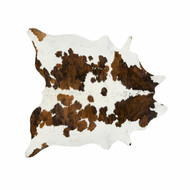Cowhide Rug Manufacturing 101
Apr 2nd 2021
 You can hardly see a cowhide rug without it conjuring images of the Old West, which is perhaps why it's such a staple in homes featuring western or rustic décor. If you love the romance of Old West themes, you want to imbue your home with the warmth inherent to the western design style, or you simply like the idea of including natural elements in your décor, you might be leaning toward cowhide pieces like rugs and furniture.
You can hardly see a cowhide rug without it conjuring images of the Old West, which is perhaps why it's such a staple in homes featuring western or rustic décor. If you love the romance of Old West themes, you want to imbue your home with the warmth inherent to the western design style, or you simply like the idea of including natural elements in your décor, you might be leaning toward cowhide pieces like rugs and furniture.
Of course, whenever you choose animal products, you may want to know where they come from. After all, you only display hunting trophies in your home because you intended for the meat to feed your family and you know the animal was killed in a relatively humane manner (as opposed to animals kept in cages, pumped full of hormones, and raised for slaughter).
Before you buy a cowhide rug, you want to know that your purchase won't offend your moral sensibilities. So, where does cowhide come from? How is it processed and how can you make sure you get the products that meet your high standards? Here's what you should know.
Is Cowhide Wasteful?
The first thing you need to understand is that cows aren't killed only for their hide. The hides used to make furniture and rugs are taken from cows that are raised for meat. This means that no waste occurs. Every part of the animal has a purpose, so the meat isn't wasted to make a rug, and the skin leftover at meat processing plants doesn't require disposal.
Where Does the Best Cowhide Come From?
There are meat packing plants all over the world, but you don't necessarily want to support operations that practice animal abuse by stuffing them into tiny cages from the day they're born until the day they're slaughtered. For this reason, it's best to look for cowhide that comes from South American countries like Argentina or Brazil.
These countries have operations that raise cattle humanely, with free-range and grass-fed animals that are healthy and happy. There are certainly producers in America and other countries that are Certified Humane, as well, but Brazil is the preferred supplier of cowhide for décor because of the additional benefits attributed to their chromium tanning process, which produces the softest, most luxurious finished products.
Finishing Touches
Once the hide is tanned, any number of finishes may be applied, from acid washes and color dyes, to stencils (like different animal prints) or even patchwork assembly.
In Conclusion
When you take the time to research cowhide rugs, you should have no trouble finding the high-end manufacturing you expect, as well as the humane products you prefer.

